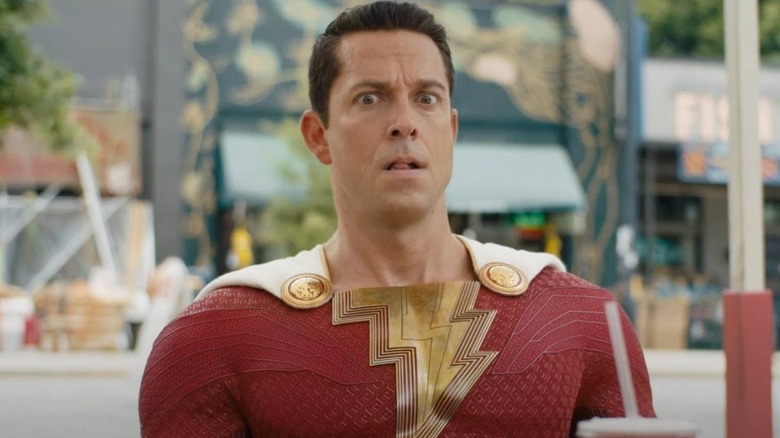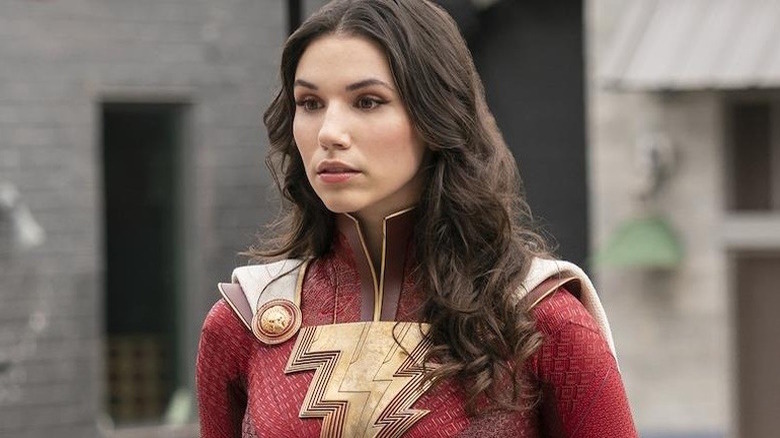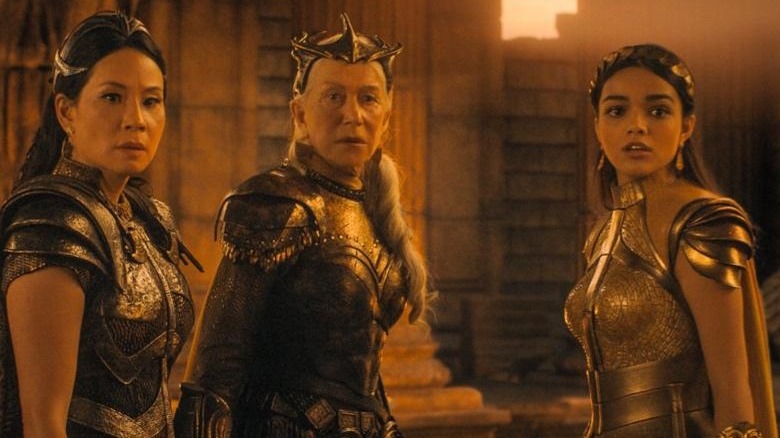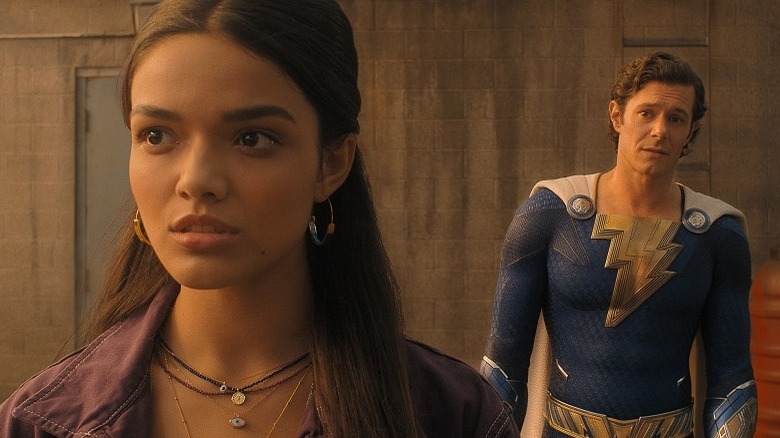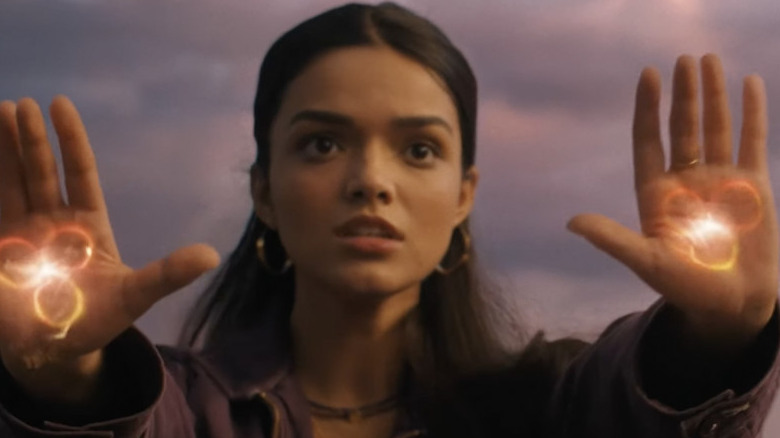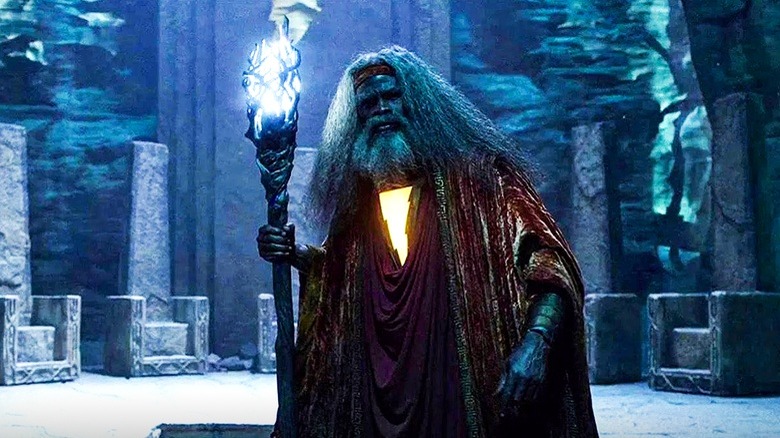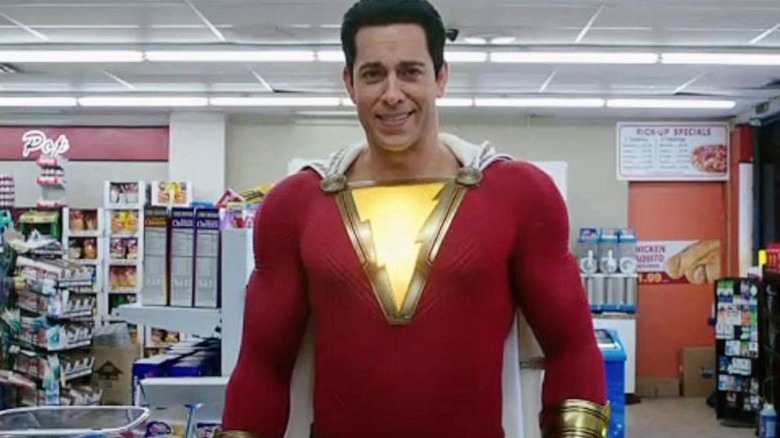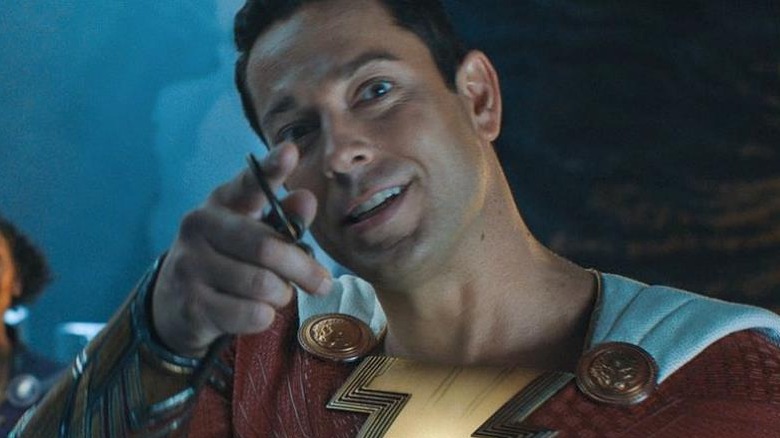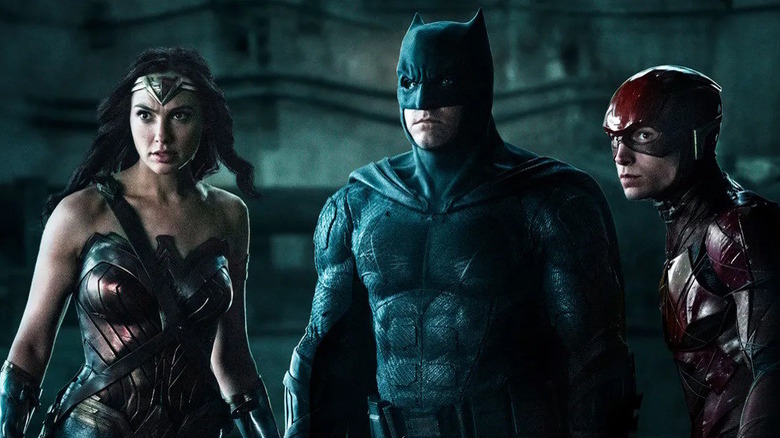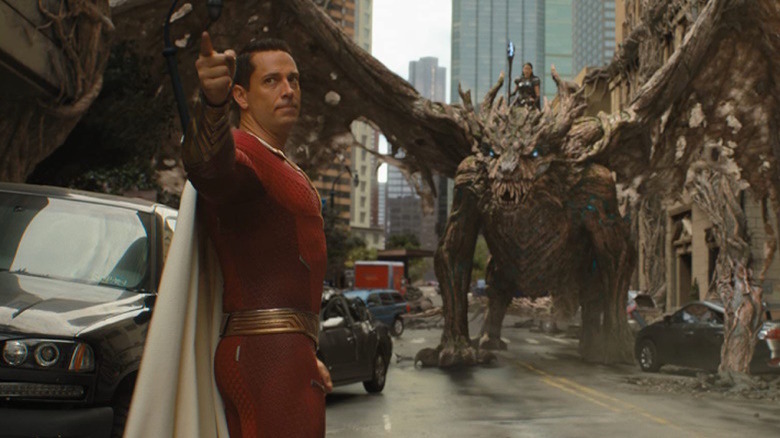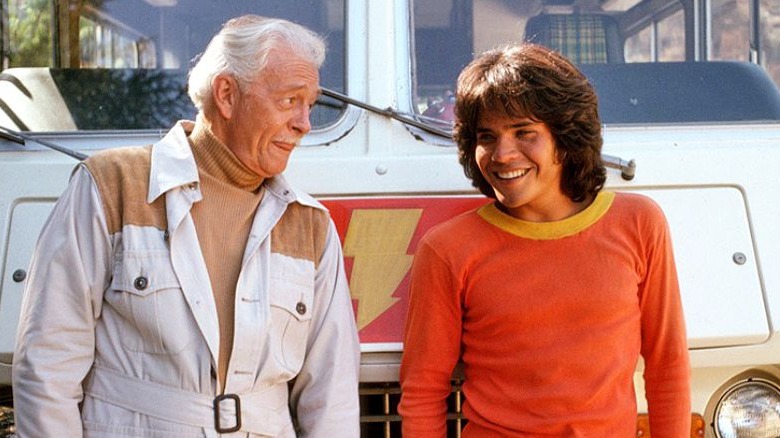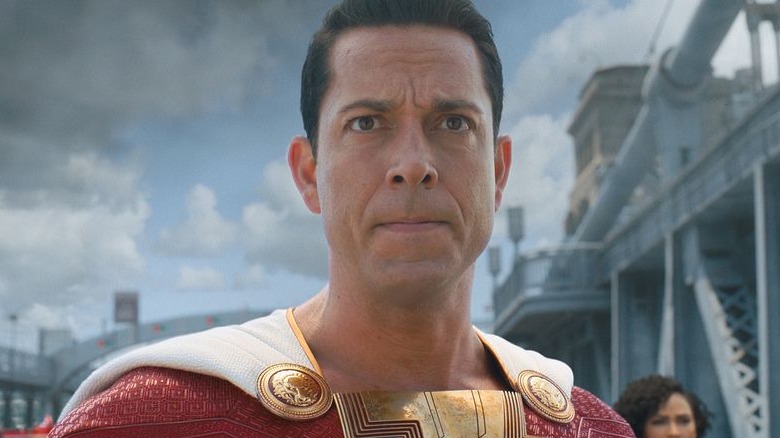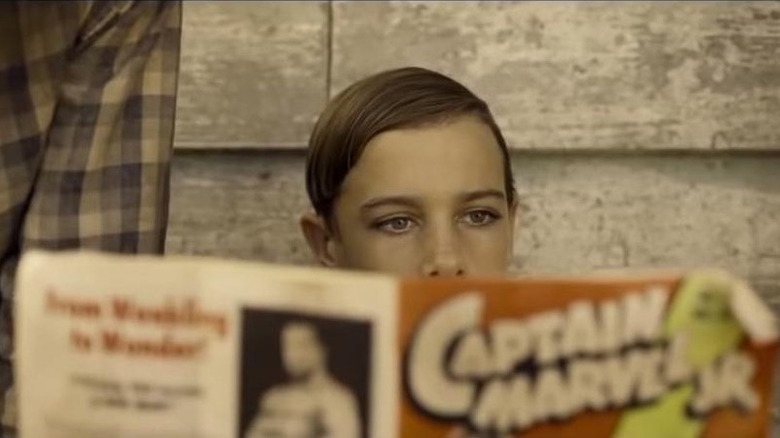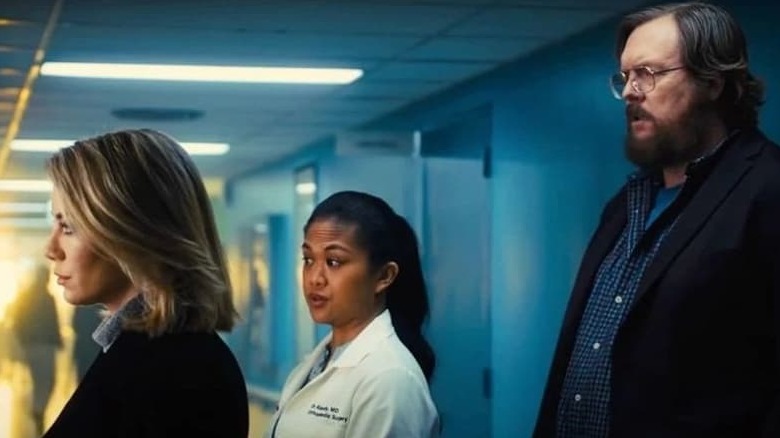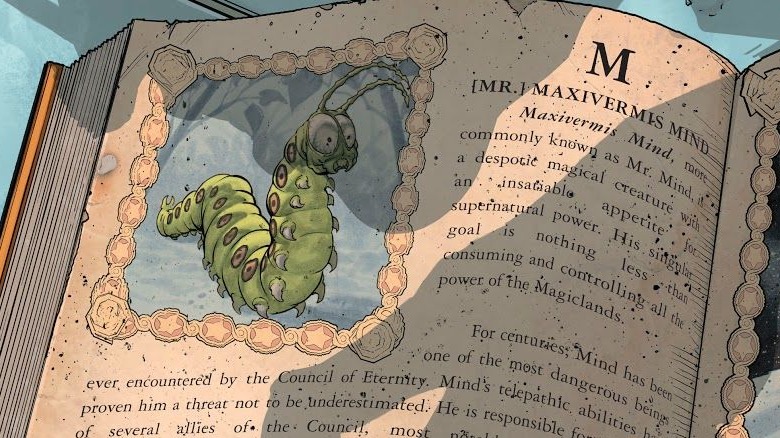Shazam! Fury Of The Gods' Most Confusing Moments Explained
Contains spoilers for "Shazam! Fury of the Gods"
Lightning finally strikes again as "Shazam! Fury of the Gods" makes its long-awaited appearance after the original "Shazam!" film first wowed audiences back in 2019. Once again, Billy Batson (Asher Angel) and his superhero alter ego Shazam (Zachary Levi) are soaring over the city of Philadelphia to protect it from magical threats — but this time they're joined by a whole family of superheroes, thanks to Billy sharing the Power of Shazam with his foster family in the first movie.
The sequel greatly expands on the original film's mythology, and we get to learn more about the magic Billy's family wields, as well as the gods who originally supplied these powers. A lot of these new developments can be tricky to understand, so we're taking an in-depth look at some of the more confusing moments of "Shazam! Fury of the Gods" and explain what's really going on in the movie.
Why does nobody notice that Mary and her superhero alter ego look exactly the same?
Superman gets a lot of flack for hiding his face behind a pair of glasses, but the Shazam family has a much better way of protecting their secret identities. By shouting the magic word, "Shazam!" the kids transform into adult superheroes who look nothing like their younger selves.
Well ... at least five of them do. Although Michelle Borth played the adult version of Grace Caroline Currey's Mary Bromfield in the original "Shazam!" movie, Currey plays both her superhero and regular self in the sequel. Since Mary's already in her late teens or early twenties, this makes sense — but why don't Mary's parents notice their daughter looks exactly like the superhero who keeps appearing on the news?
This happened all the time in the comics too. Originally, Mary Bromfield was Billy Batson's twin sister who didn't age or change her appearance when she said, "Shazam!" Mary even used the superhero name "Mary Marvel," but none of her friends or family made the connection when they saw her.
In the movie, Mary's foster mother Rosa (Marta Milans) starts to ask her husband if he sees a resemblance between one of the Shazam heroes and their kids, indicating she may be putting two and two together. Later, when the kids come clean with their parents, Billy mentions that it's "obvious" Mary and her superhero self are the same person. Maybe one of Mary's Shazam powers causes face blindness in some people. Either way, she sure doesn't seem that concerned with hiding her identity.
Who are the daughters of Atlas?
"Shazam! Fury of the Gods" pits Billy and his superpowered siblings against three new villains — the Greek goddesses Hespera (Helen Mirren), Kalypso (Lucy Liu), and Anthea (Rachel Zegler). But who are these deities?
In the movie, Hespera, Calypso, and Anthea identify themselves as the daughters of Atlas. Although Atlas exists in DC Comics, he's usually portrayed as a magical gladiator who fights Superman. The movie's version of Atlas likely takes more inspiration from the mythological Titan sentenced by Zeus to hold up the heavens.
In Greek mythology, Atlas fathered the Hesperides, the nymphs charged with guarding the Golden Apples that grew in the Garden of Hesperides. One of these nymphs was known as Hespera. Since Mirren's Hespera does seek a Golden Apple at the Rock of Eternity, she's probably that nymph.
Atlas also fathered Calypso, a nymph who appears in Homer's epic poem "The Odyssey." In the poem, Calypso transforms the Greek hero Odysseus' men into pigs and then tries to seduce Odysseus into staying with her. Liu's Kalypso is just as manipulative, although she doesn't seem to have the same transformation abilities.
Atlas did not father Anthea, who may have been inspired by the minor goddess Antheia, one of the attendants of Aphrodite. A daughter of Zeus, Antheia is a goddess of flowery wreaths and is symbolized by gold-colored items — similar to the gold wreath Zegler's Anthea wears. She also belongs to a different trio of goddesses: the Graces, who represented charm, beauty, and nature. Since the Hesperides are usually seen in groups of three, the movie probably formed a new trinity out of Hespera, Kalypso, and Anthea together ... even though Anthea isn't usually related to the other two.
What was Anne doing at Freddy and Billy's high school?
Anthea first appears as the new student "Anne Thea" at Freddy Freeman (Jack Dylan Grazer) and Billy Batson's high school, and immediately develops a friendship with Freddy. She seems interested in the time Freddy once had lunch with Shazam and Superman and gets him to show her where the meeting took place. Later, Freddy tries to impress Anne by transforming into his superhero alter ego "Captain Everypower," only for Hespera and Kalypso to arrive with the Wizard's staff and depower him.
Based on this, it looks like Anne was setting Freddy up for her sisters to ambush him. However, when Hespera interrogates Freddy later on, it's clear that none of the Daughters of Atlas have any idea the Shazam family are really children. So, what was Anthea doing posing as a student?
It's possible Anthea thought Freddy had inside knowledge of the Shazam family based on the brief encounter he once had with Shazam. However, since that lunch date happened two years ago and the Shazam family has made many public appearances since then, this doesn't make much sense. Maybe Anthea likes posing as a student so she can hang out with kids who look her age — although we can't imagine why anyone would want to spend an eternity stuck in high school.
How fast do gods age in the DCEU?
Speaking of Anthea, she looks remarkably young for her age. Hespera appears to be an elderly woman, while Kalypso looks like she's in her early fifties. However, despite the fact that she's over 6000 years old, Anthea can still pass for a high school student.
Billy Batson makes a snarky comment about the age difference between the three women, and the filmmakers may have been using the stark contrast between their ages to create a visual representation of the different stages of life. However, based on what we've seen so far in the DCEU, the question remains: Just how fast (or slowly) do gods age?
The 2017 "Wonder Woman" movie establishes that Diana (Gal Gadot) is a god, while a 2016 Empire article reveals she's over 5000 years old. Considering that Diana is younger than Anthea but looks to be a woman in her mid-thirties, it would seem that Anthea is overdue for a growth spurt.
Of course, it's also possible that gods can choose the way they look and shapeshift into the forms they feel most comfortable in. The Daughters of Atlas are also charged with protecting the Golden Apples (which confer immortality in some myths), which could explain Anthea's youthful appearance. Nevertheless, the difference between chronological and physical age is a confusing subject among gods — not to mention a disturbing one for Billy and Freddy's foster parents, who wonder why their boys are into much older women.
How did the Wizard survive?
Shortly after passing his powers on to Billy Batson in the first "Shazam!" movie, the Wizard Shazam (Djimon Hounsou) disintegrates in front of Billy, seemingly dying. Yet in "Shazam! Fury of the Gods," the Wizard turns up, having been imprisoned by the Daughters of Atlas. Crumbling into dust sure seems like a definitive death, so how did the Wizard survive?
While sharing a cell with Freddy Freeman, the Wizard discloses that after giving Billy his powers, he could no longer stay in the mortal realm and had to go to an afterlife kingdom where he was presumably imprisoned by Hespera and Kalypso. However, once the Wizard escapes from the gods' world, he seems to have no trouble walking among the mortals, getting a makeover, or taking Uber rides. So, what gives?
In the comics, the Wizard also dies after giving Billy his powers when a heavy stone crushes his body. However, his ghost remains at the Rock of Eternity to guide Billy on his adventures. Later, in the "Power of Shazam!" comic book series by writer/artist Jerry Ordway, the Wizard regains his physical body and goes to live with Billy, showing how common resurrections are in superhero comics.
In the movie, it's possible that the Wizard got a jolt of magic from the pieces of his broken staff after the Daughters of Atlas forced him to repair it, allowing him to stay alive in the mortal realm. During the final scene, he visits Billy's home to reclaim the staff, indicating he may need its magic to remain corporeal.
Does Billy have the Wisdom of Solomon?
In "Shazam! Fury of the Gods," Billy finally learns that the magic word "SHAZAM" is an acronym for the gods and heroes the Shazam family draws their powers from. Billy certainly has the "Strength of Hercules" and the "Speed of Mercury." However, his foster brothers and sisters are quick to point out that he doesn't seem to ever use one power — the "Wisdom of Solomon."
Billy certainly doesn't get any smarter when he shouts "Shazam!" He admits his sister Mary is better at "thinking" than he is and often feels he doesn't know how to use his powers properly. So, does Billy possess the wisdom of Solomon, or did that power skip him?
In the comics, the Wisdom of Solomon manifests in several ways. Occasionally, it does grant Billy a higher IQ as well as an intuitive grasp of mathematics, sciences, and engineering. In "The Power of Shazam" graphic novel by Jerry Ordway, Billy describes the wisdom as "too many people talking to me at once — telling me what to do." In certain stories, the wisdom lets Billy speak every language on Earth.
Other times, the wisdom just alters Billy's personality, making him a more moral person. In "JSA" #48 by David Goyer and Geoff Johns, Billy admits he can't cheat when he uses his powers and perhaps uses them to behave ethically. The Wizard acknowledges that Billy's true wisdom lies in his heart, and Billy proves this later by sacrificing his life (albeit temporarily) to save his family.
Why didn't the Shazam family just ask Steve the Pen how to beat Hespera?
While exploring the Rock of Eternity, the Shazam family discovers "Steve," a sentient pen who can answer any question by writing his responses on scraps of paper. Steve's knowledge of magic is vast — you might even say you can "Shazam" any answer out of him. The kids use Steve to locate several books on the Daughters of Atlas, and Billy later dictates several letters to Hespera using Steve.
But it's Darla (Faithe Herman) who finally starts using Steve properly. After Kalypso unleashes several monsters on the city, Darla asks Steve how to beat them, prompting the pen to tell everyone about the "king of beasts": Vicious unicorns that can overpower the strongest Minotaur or harpy. Thus informed, the kids tame a bunch of unicorns with Skittles, of all things, and use them to impale the other monsters.
Cool scene — but if Steve knows so much, why didn't any of the kids think to ask him for step-by-step instructions on the best way to beat the Daughters of Atlas? Granted, Steve's writings are a bit cryptic, but he'd probably still come up with a better plan than "fly really fast and hope the Wizard's staff doesn't depower you." The kids may possess the Wisdom of Solomon, but it's clear that Steve's the one with the real brains.
Where were all the other DC superheroes?
By now, the DCEU is full of superheroes. From Superman to Aquaman to the Justice Society, there really isn't a shortage of superbeings to protect us when evil forces threaten the world. So what were all of them doing when the Daughters of Atlas created a mystic dome around the entire city of Philadelphia?
Billy knows Superman from the first "Shazam!" movie. He had Steve send a magic letter to Wonder Woman. And Amanda Waller (Viola Davis) clearly has the Shazam family under surveillance, given the way her people were trying to recruit Billy for the Justice Society in the mid-credits scene.
Yet out of all these superheroes, only Wonder Woman bothered to make an appearance — and even she waited until after Billy died defeating the bad guys. Seeing as how the Daughters of Atlas are clearly a global threat, you'd think the Justice League and Justice Society would be mobilizing outside the dome and preparing countermeasures. Something big had to be happening elsewhere in the world to occupy everyone's attention. Or maybe the City of Brotherly Love just doesn't rate very high on most superhero radars.
Why were people fine with Shazam smashing a dragon through a building?
In "Man of Steel" and "Batman V. Superman," Superman (Henry Cavill) finds himself branded an alien menace due to all the destruction he inadvertently causes fighting Zod and his Kryptonian army. Scenes of Superman smashing Zod through skyscrapers do look terrifying from the ground, and it's understandable that people would be nervous about having someone that powerful flying over them.
Yet when Billy shoves a dragon through a skyscraper and causes similar destruction, the onlookers don't run away in terror. Instead, they clap and cheer for their local hero. This is a surprisingly charitable response, especially after the media claims the city turned against the Shazam family (whom they dub "The Philadelphia Fiascos"). So, why the sudden change of heart?
It's likely these people have gotten really good at evacuating buildings during superhero fights, since it's practically a given that people will come smashing through the windows during these events. Plus, most citizens have probably gotten much more desensitized to carnage after witnessing Darkseid's invasion during "Justice League" or Starro's rampage through Corto Maltese in "The Suicide Squad." People get impaled or turned into stone all the time in "Shazam! Fury of the Gods," yet everyone treats these events as everyday annoyances.
Why wasn't everybody more afraid of the dragon?
The dragon the Shazam family battles during the film's climax is creepy — but according to the Wizard, everyone should have been way more terrified of it. That's because the dragon radiates fear, causing intense panic in those nearby. Both Freddy and the Wizard are nearly paralyzed with fear when they first encounter the dragon. Yet somehow, this fear effect becomes increasingly diluted during the actual fight scenes.
Shortly after Billy smashes the dragon through a building, several citizens linger in the background to watch the continuing fight. Billy possesses the "Courage of Achilles," which may grant him some immunity to the dragon's power, but that doesn't explain why your average citizen can stand up to it.
Then again ... maybe they weren't all average citizens. Sharp-eyed viewers may have noticed one of the onlookers was former child actor Michael Gray, who played the original Billy Batson in the 1970s "Shazam!" TV series. Still sporting his trademark red sweater, Gray cheers for Billy and calls him "Captain Marvel" — the same superhero name he used when he transformed into Shazam.
With the upcoming "Flash" movie hyping up the DC multiverse, could it be possible that Gray is playing a Billy Batson who crosses over from another universe? Maybe those other citizens feel more reassured that there are now two heroes with the "Courage of Achilles" looking out for them.
How is Shazam supposed to introduce himself from now on?
In the film's final scene, the Wizard finally settles a big question when he formally establishes that Billy Batson's superhero name is ... Shazam. While this doesn't really come as a surprise to anyone, it does raise a confusing point. Namely — how is Billy supposed to tell anyone his name without accidentally depowering himself and exposing his secret identity?
This was actually a big problem for multiple characters in "Shazam!" comic books. In some of the early comics, Billy shared some of his power with Freddy Freeman, allowing him to transform into the hero Captain Marvel Jr. by shouting "Captain Marvel!" As a result, Freddy couldn't tell anyone his name, so he usually just went by "Junior" or "CM3."
Later, when Billy started to go by the name "Shazam," writers altered his powers a bit, establishing that he had to want to change into Shazam for the magic word to bring down the lightning. We don't know if this applies to the movie version, but Billy/Shazam will likely have a lot of awkward moments if he starts giving interviews.
Why is there an Elvis song playing during the end credits?
The original "Shazam!" movie ends, appropriately enough, with the Ramones "I Don't Want to Grow Up" playing during its end credits. For "Shazam! Fury of the Gods," the filmmakers chose a decidedly different song — Elvis Presley's 1968 hit single "A Little Less Conversation." Catchy, but ... why?
Turns out, Presley had a very strong connection to the original "Shazam!" comic books. When he was a kid, Elvis enjoyed collecting and reading "Captain Marvel Jr." comic books starring Freddy Freeman. Many fans believe Elvis patterned his trademark hairstyle after Captain Marvel Jr.'s look, and some of his sport capes and lightning bolt symbols are similar to the Shazam costumes. The 2022 "Elvis" biopic starring Austin Butler references this by having the legendary singer admit he wanted to be Captain Marvel Jr. and reach the Rock of Eternity.
DC Comics went on to acknowledge this history by making Freddy Freeman a huge Elvis fan in the modern "Shazam!" comic books. In some of these stories, Freddy styles his hair to look like Elvis and enjoys listening to his music. It's a touching homage to the King that the movie continues with its final credits song.
Who were those people trying to recruit Billy in the mid-credits scene?
With "Shazam! Fury of the Gods" aimed toward a younger audience, not everyone will recognize the man and woman who show up during the mid-credits scene to recruit Billy Batson for the Justice Society. However, fans of "The Suicide Squad" and James Gunn's "Peacemaker" HBO series will know the two as Emilia Harcourt (Jennifer Holland) and John Economos (Steve Agee), two underlings of Amanda Waller who work to protect the planet from parahuman threats.
Having two of Waller's people show up to recruit Billy may be an attempt to tie the movie to 2022's "Black Adam," which saw Dwayne Johnson's anti-hero take on the Justice Society. During the mid-credits scene, Amanda Waller contacts Black Adam and threatens to send powerful beings after him if he leaves his home country of Khandaq. Waller's already sent Superman after Black Adam — if her people are trying to recruit Billy, she may be preparing another "big gun" to use against Black Adam.
In the comics, both Shazam and Black Adam end up joining the Justice Society, although things continue to be pretty tense between them. With the upcoming "Flash" movie promising a reboot of the entire DC movie franchise, it's unknown if we'll see the Shazam/Black Adam storyline play out, but the groundwork has been set.
Who is that weird talking worm in the post-credits scene?
The original "Shazam!" movie ends with the main villain, Doctor Sivana (Mark Strong), encountering a talking green worm who proposes a team-up. In the post-credits scene of "Shazam! Fury of the Gods," we see that Sivana is still in his cell and has been stuck there for two years as the worm slowly gathers what he needs for his master plan. The worm briefly returns to inform Sivana that he needs just one more thing before slithering away and leaving the mad scientist to stew in prison.
So, who is this talking worm? Long-time fans will recognize him as "Mister Mind," one of Billy Batson's classic enemies who first appeared back in 1943's "Captain Marvel Adventures" #22, back when "Shazam!" comics were still published by Fawcett Comics. A telepathic alien worm with mind control powers, Mister Mind is much more dangerous than he looks, and has masterminded several world-threatening plots in both Fawcett Comics and DC Comics.
Whether or not we get to see Mister Mind's master plan play out on the big screen is anyone's guess. Director David F. Sandberg admitted that the original plan for the Shazam sequel was to pit the Shazam family against Doctor Sivana, Mister Mind, and the Daughters of Atlas. However, this became too complicated, so Sivana and Mister Mind were relegated to a post-credits cameo scene. Given that the Flash is about to reboot the entire DC movie universe, Mister Mind better crawl pretty fast if he wants to see his plan come to fruition. Time's about to run out.
